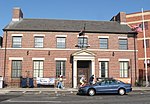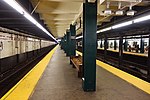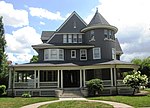Fort Hamilton Parkway station (IND Culver Line)
1933 establishments in New York CityIND Culver Line stationsNew York City Subway stations in BrooklynNew York City Subway stations located undergroundRailway stations in the United States opened in 1933 ... and 1 more
Use mdy dates from January 2017

The Fort Hamilton Parkway station is a local station on the IND Culver Line of the New York City Subway. It is served by the F and G trains at all times. This underground station, opened on October 7, 1933, has two tracks and two side platforms. The Culver Line's express tracks run underneath the station and are not visible from the platforms.
Excerpt from the Wikipedia article Fort Hamilton Parkway station (IND Culver Line) (License: CC BY-SA 3.0, Authors, Images).Fort Hamilton Parkway station (IND Culver Line)
Prospect Avenue, New York Brooklyn
Geographical coordinates (GPS) Address Nearby Places Show on map
Geographical coordinates (GPS)
| Latitude | Longitude |
|---|---|
| N 40.651455555556 ° | E -73.975855555556 ° |
Address
Prospect Avenue 1292
11218 New York, Brooklyn
New York, United States
Open on Google Maps










